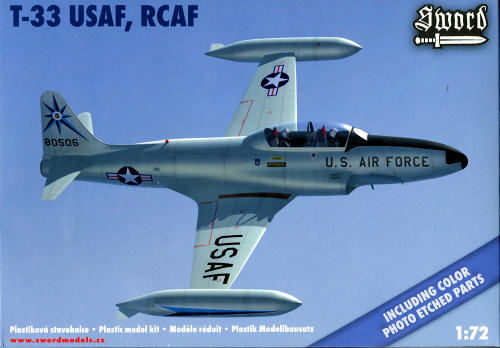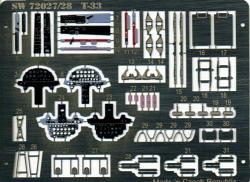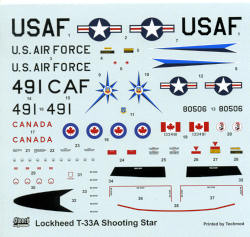
Sword 1/72 T-33A Shooting Star
| KIT #: | 72027SE |
| PRICE: | $21.55 at www.greatmodels.com |
| DECALS: | Two Options |
| REVIEWER: | Scott Van Aken |
| NOTES: | Multi-media kit with photo etch and resin parts |

| HISTORY |
The T-33 (aka "T-Bird") was developed from theLockheed P-80/F-80 by lengthening thefuselage by slightly over three feet and adding a second seat, instrumentation and flight controls. It was initially designated as a variant of the P-80/F-80, the TP-80C/TF-80C.
Design work for the Lockheed P-80 began in 1943 with the first flight on 8 January 1944. Following on theBell P-59, the P-80 became the first jet fighter to enter full squadron service in theUnited States Army Air Forces. As more advanced jets entered service, the F-80 took on another role - training jet pilots. The two-place T-33 jet was designed for training pilots already qualified to fly propeller-driven aircraft.
Originally designated the TF-80C, the T-33 made its first flight on 22 March 1948 with US production taking place from 1948 to 1959. TheUS Navy used the T-33 as a land-based trainer starting in 1949. It was designated the TV-2, but was redesignated the T-33B in 1962. The Navy operated some ex-USAF P-80Cs as the TO-1, changed to the TV-1 about a year later. Acarrier-capable version of the P-80/T-33 family was subsequently developed by Lockheed, eventually leading to the late 1950s to 1970sT2V-1/T-1A SeaStar. A total of 6,557 Shooting Stars were produced, 5,691 by Lockheed.
| THE KIT |
 This is the fourth or perhaps fifth Shooting Star variant that Sword has produced in 1/72 scale. I built the F-80C kit and found it to be generally well done and while perhaps not for the
This is the fourth or perhaps fifth Shooting Star variant that Sword has produced in 1/72 scale. I built the F-80C kit and found it to be generally well done and while perhaps not for the bare beginner, is a well executed kit. You'd think that there would be many of the same sprues from kit to kit, but this has generally not been the case.
bare beginner, is a well executed kit. You'd think that there would be many of the same sprues from kit to kit, but this has generally not been the case.
The T-33 requires new fuselage halves, new wing tip tanks, new interior and canopy. Sword does the multi-media approach with resin for the seats, wheel wells and a few other bits. Photo etch is used for most of the interior details, including instrument panels and for landing gear retraction struts, speed brake detailing, and oleo scissors to name a few. The etched set is in color, which is very nice.
The intake design is probably going to cause the most difficulty with builders. It is split into upper and lowe r sections with the lower section being incorporated into the lower wing. It makes for a somewhat difficult seam to fill and truly, you'll need either super glue or thin card to get a clean intake lip. There are no real options as the T-33 was pretty much the same no matter who flew it. The Canadians did have a larger engine that requires an additional exhaust port on the aft fuselage. This is something that some decal sheets offer as a decal or you can drill this out.
r sections with the lower section being incorporated into the lower wing. It makes for a somewhat difficult seam to fill and truly, you'll need either super glue or thin card to get a clean intake lip. There are no real options as the T-33 was pretty much the same no matter who flew it. The Canadians did have a larger engine that requires an additional exhaust port on the aft fuselage. This is something that some decal sheets offer as a decal or you can drill this out.
The Pavla kit offers two decal options. One is an ADC Grey aircraft with the 318 FIS and the other is an unpainted metal plane with 414 Squadron, CAF. This latter plane could be painted with aluminum lacquer as it was not something that was uncommon. The CAF plane also has red bits on the wing tips, outer tip tanks and tail planes. Decals are very nicely printed by Techmod and include nose anti-glare panel and wing walk panels. Kit instructions are typical Sword and offer generic color references.
| CONCLUSIONS |
Overall, it is a very nice kit for this most important aircraft. Flown by literally dozens of nations, many are still extant as war birds and some may still be in military use. With some thoughtful building, it will make into an excellent replica for your display shelves.
| REFERENCES |
July 2011
You can find this and many other fine kits and accessories at www.greatmodels.com .
If you would like your product reviewed fairly and fairly quickly, please contact the editor or see other details in the